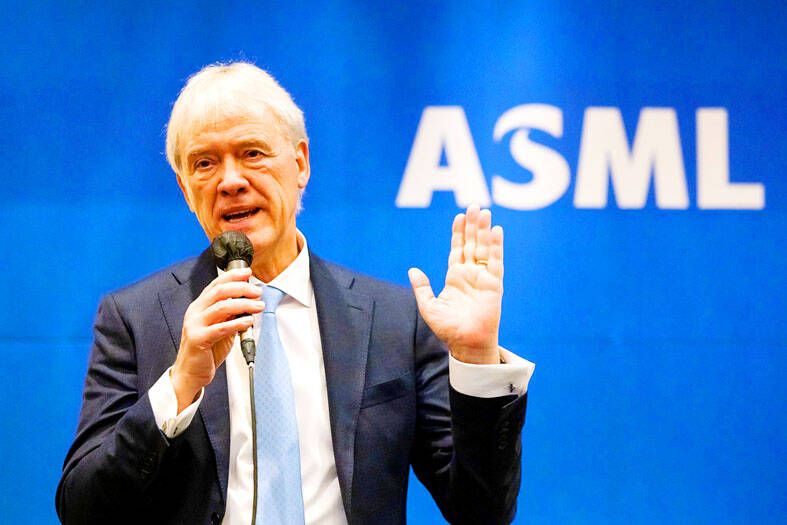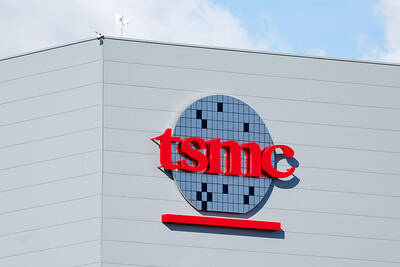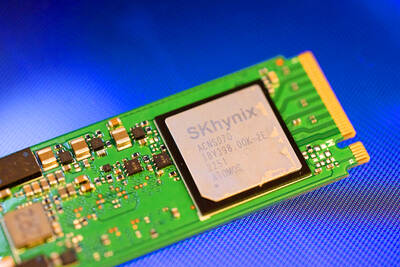ASML Holding NV might conduct acquisitions to meet soaring demand for advanced chips worldwide, its chief executive officer said yesterday, defying the broader sector downturn.
The Dutch chip production equipment maker continues to see strong demand for the foreseeable future, as countries race to build domestic chip plants. It last week said it expects sales to more than double to as much as 40 billion euros (US$41.7 billion) by 2025 and more than tripling to as much as 60 billion euros by 2030.
That scale of growth necessitates a bigger supplier base, CEO Peter Wennink said.

Photo: Bloomberg
“We will acquire what we think is needed to support the road map,” he said, speaking at a news conference in Seoul a day ahead of a groundbreaking ceremony of ASML’s new facilities in South Korea.
ASML is investing 240 billion won (US$182.95 million) to build maintenance and training centers in South Korea by 2024, it said in a statement.
ASML’s investments in South Korea are “just beginning,” Wennink said.
Some of its biggest customers — South Korea’s Samsung Electronics Co and SK Hynix Inc, as well as Taiwan Semiconductor Manufacturing Co (台積電) — are in East Asia, which is also home to fellow lithography machine makers Nikon Corp and Canon Inc.
ASML long played a low-profile role supplying equipment for making semiconductors, but its strategic importance has surged as the US and China clash over technology leadership. The Dutch company holds a monopoly on the type of machine commonly used to make the most powerful chips.
ASML has been selling slightly less advanced chipmaking machines to Chinese customers. While the most recent chip curbs from US President Joe Biden’s administration do not directly affect the Dutch maker, they could mean an indirect hit to sales of as much as 5 percent, Wennink said.
“Despite the fact that we are looking at a recessionary environment in 2023, the demand for our products is still higher than what we can make,” he said.
There has been no reduction to the backlog in its shipments to the end of next year, he said.
The company is raising output to 90 of its extreme ultraviolet lithography machines and 600 deep-ultraviolet machines by 2025 to 2026. Such machines burn patterns into materials deposited on wafers of silicon that make up the circuits that give chips their function.
Five companies dominate the global market for the equipment needed to produce semiconductors. The others, supplying other parts and machinery for the task, are Japan’s Tokyo Electron Ltd, and three US companies, Applied Materials Inc, Lam Research Corp and KLA Corp.
Separately, Chinese President Xi Jinping (習近平) urged Dutch Prime Minister Mark Rutte to avoid “decoupling” as the US pressures the Netherlands to avoid selling high-end chipmaking machines to China.
In a meeting yesterday in Bali, Indonesia, where they are both attending a G20 summit, Xi stressed the need for cooperation and said China would work with the Netherlands to “maintain and practice genuine multilateralism,” state broadcaster CCTV reported.
“We must oppose the politicization of economic and trade issues and maintain the stability of the global industrial chain and supply chain,” Xi told Rutte.
Rutte is due to visit semiconductor giant South Korea later this week, with the US export controls high on the agenda. Since early last month, US officials have repeatedly said that if allies do not align with Washington on the latest rules, they could ban sales of foreign chip equipment that contains even the smallest amount of US technology.

Taiwan Semiconductor Manufacturing Co (TSMC, 台積電) secured a record 70.2 percent share of the global foundry business in the second quarter, up from 67.6 percent the previous quarter, and continued widening its lead over second-placed Samsung Electronics Co, TrendForce Corp (集邦科技) said on Monday. TSMC posted US$30.24 billion in sales in the April-to-June period, up 18.5 percent from the previous quarter, driven by major smartphone customers entering their ramp-up cycle and robust demand for artificial intelligence chips, laptops and PCs, which boosted wafer shipments and average selling prices, TrendForce said in a report. Samsung’s sales also grew in the second quarter, up

LIMITED IMPACT: Investor confidence was likely sustained by its relatively small exposure to the Chinese market, as only less advanced chips are made in Nanjing Taiwan Semiconductor Manufacturing Co (TSMC, 台積電) saw its stock price close steady yesterday in a sign that the loss of the validated end user (VEU) status for its Nanjing, China, fab should have a mild impact on the world’s biggest contract chipmaker financially and technologically. Media reports about the waiver loss sent TSMC down 1.29 percent during the early trading session yesterday, but the stock soon regained strength and ended at NT$1,160, unchanged from Tuesday. Investors’ confidence in TSMC was likely built on its relatively small exposure to the Chinese market, as Chinese customers contributed about 9 percent to TSMC’s revenue last

LOOPHOLES: The move is to end a break that was aiding foreign producers without any similar benefit for US manufacturers, the US Department of Commerce said US President Donald Trump’s administration would make it harder for Samsung Electronics Co and SK Hynix Inc to ship critical equipment to their chipmaking operations in China, dealing a potential blow to the companies’ production in the world’s largest semiconductor market. The US Department of Commerce in a notice published on Friday said that it was revoking waivers for Samsung and SK Hynix to use US technologies in their Chinese operations. The companies had been operating in China under regulations that allow them to import chipmaking equipment without applying for a new license each time. The move would revise what is known

UNCERTAINTY: A final ruling against the president’s tariffs would upend his trade deals and force the government to content with billions of dollars in refunds The legal fight over US President Donald Trump’s global tariffs is deepening after a federal appeals court ruled the levies were issued illegally under an emergency law, extending the chaos in global trade. A 7-4 decision by a panel of judges on Friday was a major setback for Trump, even as it gives both sides something to boast about. The majority upheld a May ruling by the Court of International Trade that the tariffs were illegal. However, the judges left the levies intact while the case proceeds, as Trump had requested, and suggested that any injunction could potentially be narrowed to apply